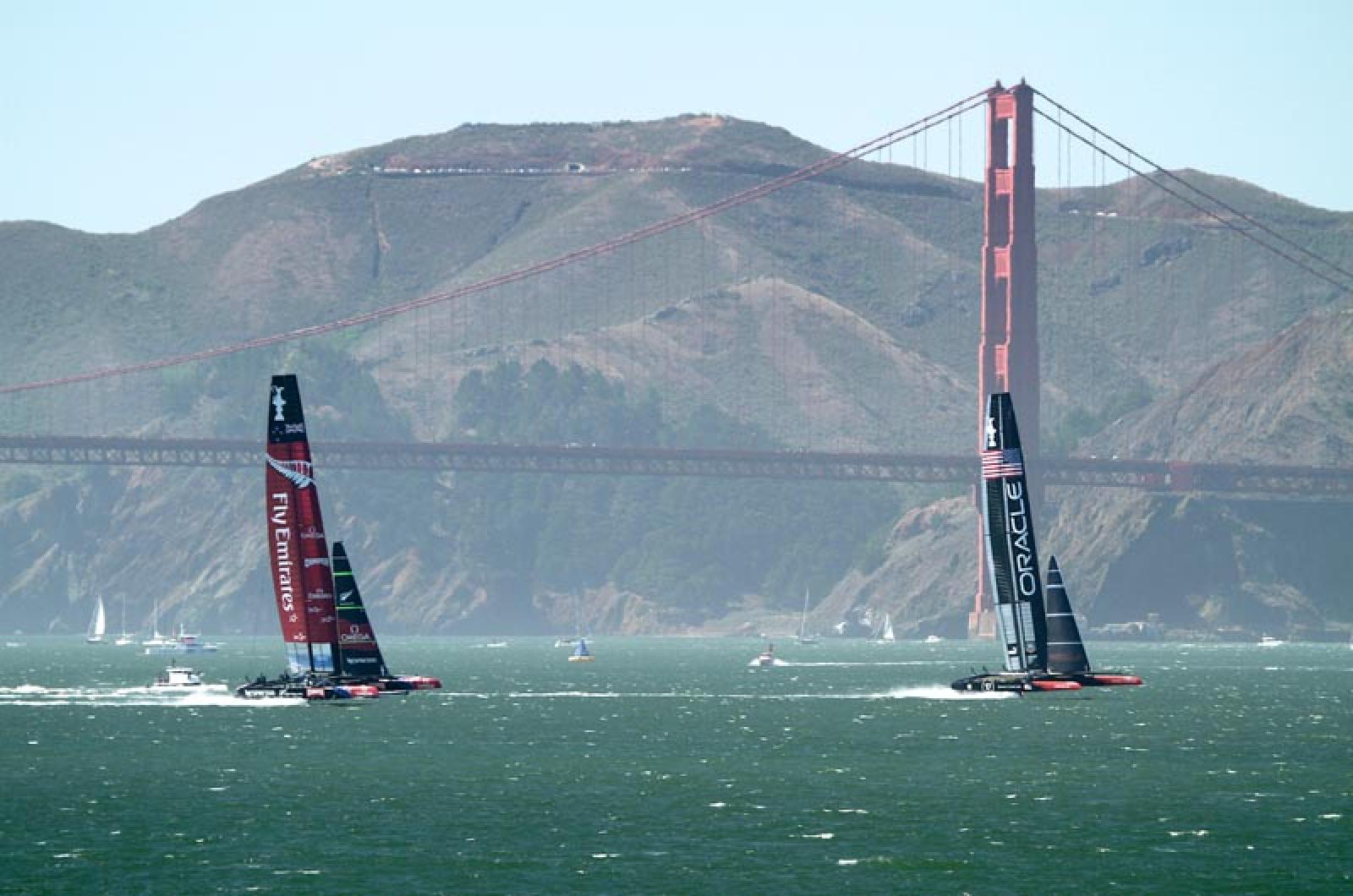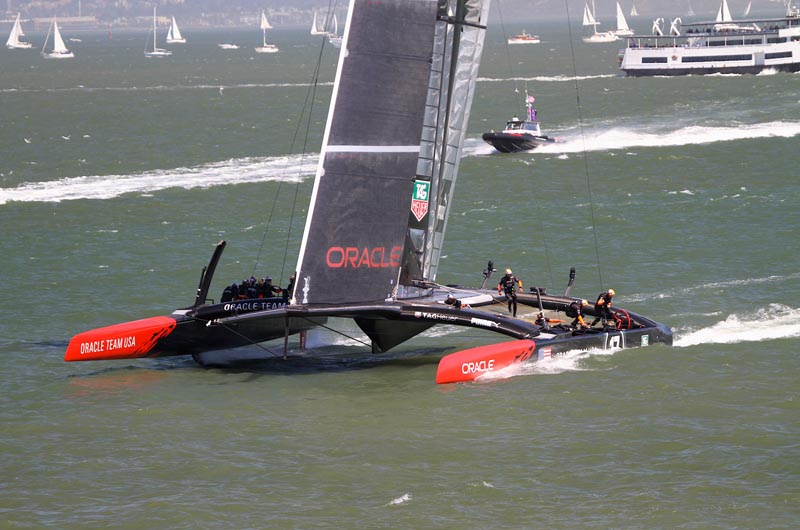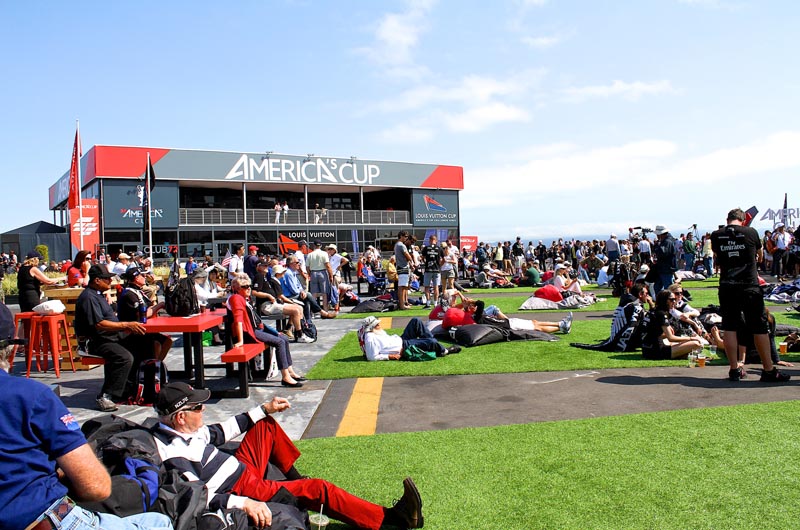Wow! The new generation of AC 72 yachts (America’s Cup-designed, 72 feet long) are impressive in both design and speed. These new racing machines are sexy, fast and dangerous. They are also exciting and fun to watch at the match race in San Francisco Bay.
This, the 34th America’s Cup, is a match race between defender Oracle Team USA and challenger Team New Zealand, sponsored by the airline Emirates. Match racing is a contest between two yachts with the first boat to win nine races declared the winner. However, Oracle Team USA was caught cheating and was penalized two points. Oracle in effect broke their own rules by placing extra weights on the America’s Cup 45 boats. So in order for Oracle Team USA to win they have to win 11 matches and Team New Zealand only has to win nine. At press time for this newspaper, Team New Zealand was leading Oracle 8-1 (although Oracle has won three matches). The Kiwis only have to win one more match.
The America’s Cup has been raced since 1851 and is considered one of the oldest sporting events. The Auld Mug, as it is known, is also one of the most coveted and controversial sporting events in the world. It is a cup of controversy as events take place on and off the water. Oracle Team USA led by Larry Ellison won the right to challenge defender Alinghi in the 33rd cup by taking the defender to court for over a year. The holder of the cup, the defender, gets to write some of the rules for that cup in the protocol. For example Larry Ellison, chief executive officer of Oracle and his team of Russell Coutts put forth a new generation of America’s Cup boats, catamarans in the 34th protocol. Larry and Russell wanted the Cup to appeal to a wider audience with faster speeds and stadium seating. The Cup format changed to be a series of events over several years leading up to the actual Cup race, going on now. In the interim years the teams have been racing one design America’s Cup 45s (catamarans that are 45 feet in length and all the same design). However, the Americans allowed the 45s to be built in Auckland, New Zealand. This, I feel, was a fatal mistake on the part of the U.S. By allowing the 45s to be built in New Zealand we gave up some of our competitive edge.
Team New Zealand hired some of the best cat yacht designers, which included American Pete Melvin. The New Zealand designers basically created new foiling designs for these cats. Team New Zealand was the first to effectively use the foils 100 per cent and each team has been trying to catch up ever since. The America’s Cup is all about design. The U.S. wrote the rules and the Kiwis jumped on the design innovation. These Cup boats are still in development, and each race is proving pivotal to the learning curve for this new design. (Look at the images to see the foils — the thin pieces that prop up the boat). Oracle Team USA has been able to modify their boat during the cup and make it faster and closer in boat speed to Team New Zealand, however the Kiwi team is superior in both teamwork and tactics.
Team New Zealand also had the benefit of racing in the Louis Vuitton Series. This is the challenger series prior to the cup to determine who will race the defender. Team New Zealand had two months of racing on San Francisco bay to learn local conditions, modify their boat and perfect their teamwork. Most of the guys on Team New Zealand have been racing together for years. It shows in every jibe and tack. They simply know their boat and have virtually flawless teamwork. For example when the Kiwis almost capsized, it was only by teamwork that they were able to stay afloat. By contrast, the U.S. was only able to get up to speed in terms of boat handling and modifications to their boat half way through the regatta. Nonetheless, now that the U.S. is up to speed, this regatta has provided some unbelievable match racing. There have never been so many lead changes in one race. This cup has seen the fastest speeds of any cup, with average speeds in the high 30s and low 40s, toping out at 50 knots. I was on a Volvo Ocean Race boat in 2002 and hit speeds of 34.7 knots which felt like being on an amusement ride. So to think this is an average speed is basically crazy, performing at such a high level for an entire race. This America’s Cup has seen the closest racing of any cup, for example, four-second deltas. Years ago the delta could be seven minutes.
The Kiwis have maintained solid teamwork and sailing tactics. Tactician Roy Davies has been outstanding in almost every race and call. The U.S. recognized this and changed their tactician midway through the regatta. But the change has not been enough to overcome the Kiwis’ outstanding strategy and tactics.
Another advantage I think the Kiwis have is that all but three of their sailors are from New Zealand, whereas the U.S. boat has only one American on board. The Kiwis are racing for New Zealand and to bring the cup back to their country. The rumor is if Team New Zealand wins they will reinstitute the nationality rule. I tend to think this would be a great idea, and return the cup to nation versus nation in high-speed sailing machines. It seems that Team USA is more a corporate team than one of close-knit sailors racing for their home country.
San Francisco has been a great venue to watch the racing. All along the waterfront there are views of the regatta, along with Alcatraz, the bay and Sausalito across the bay. In Auckland it took more than an hour to get to the start line by boat, and another hour to reach the windward mark. Television and Youtube coverage has been excellent. The entire setup at the Cup village has allowed the public to see the teams, unlike in any previous cup. In this regard, Larry and Russell’s vision of bringing sailing to the masses in fast catamarans has become a reality.
These boats are true sailing machines flying on foils at three times the speed of the wind. The wing or sail is 130 feet tall. It will be exciting to see the next development of the winged sailboat on foils.
A friend came with me from the Vineyard; she has been bitten by the Cup and will join our ever-growing group of friends and yachties from around the world who will gather in Auckland for the 35th America’s Cup. It’s time to pull out my red socks. The next Cup, from everything I have learned firsthand, will be in the new generation of cats, however the 35th protocol will provide the new guidelines. Although this regatta might be almost over on the water, news and talk will continue about the next cup. A new viaduct or harbor will need to be built or reconfigured in Auckland. I would think that the cup would be held in two to three years’ time to keep the momentum going. America’s Cup teams now hire and obtain sailors from cup to cup, and it will be interesting to see if they continue the Cup 45 interim regattas.
Louisa Gould has been involved with America’s Cup campaigns since 1999, living in both Auckland, New Zealand and Valencia, Spain. To see more images, visit louisagould.com or stop by the Louisa Gould Gallery at 54 Main street Vineyard Haven.









Comments
Comment policy »